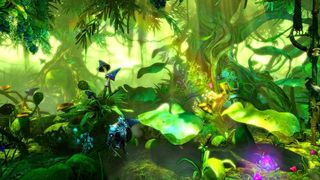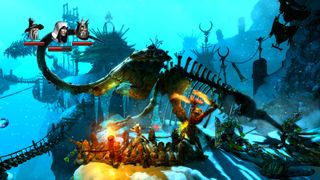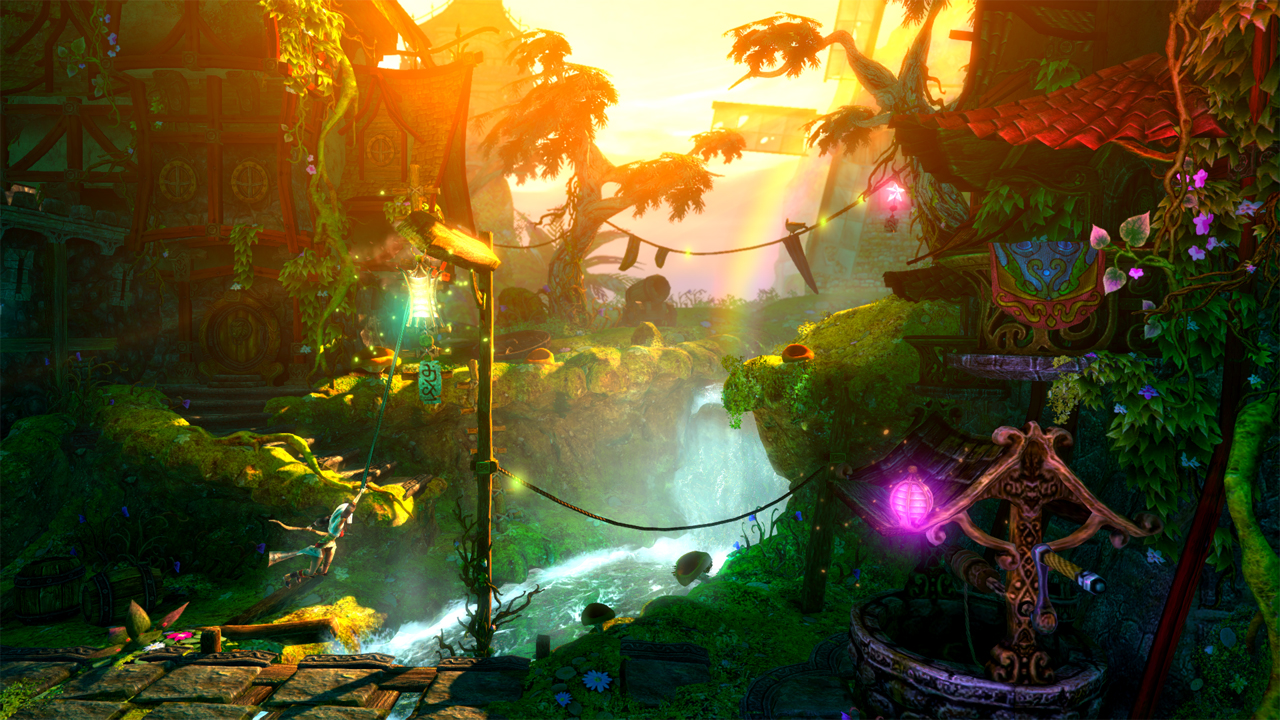GamesRadar+ Verdict
Pros
- +
So beautiful it hurts
- +
Brain-caressing puzzles
- +
Wonderful co-op
Cons
- -
Doesn't really add much to the formula
- -
Puzzles could have been expanded more
- -
Makes other games look ugly
Why you can trust GamesRadar+
Holy god is Trine 2 beautiful. It’s honestly one of the prettiest, most eye-pleasing games we’ve ever played. Yet it’s also a mere $14.99 on Steam, and like its predecessor, is a simple puzzle-platformer with humble ambitions. It really says something about how color choice can affect the aesthetic experience: sure the graphics are sharp if you turn everything to the max, but it’s the softly glowing royal-purple cave toadstools, the greener-than-emerald giant platform leaves, the so-turquoise-it-hurts-your-eyes underwater scenes that come together to create the most scintillating color palette we’ve seen in who knows how long.

Above: Man, just look at this. If you're still not impressed, you have to see it in motion
The background details are equally incredible: how often do you enter a room in a 2D platformer and stop your character to just sit there, lean toward the monitor, and let your eyes crawl over every nook and cranny to admire the astounding variety of neat things piled up and tucked away? It’s almost pornography for the part of your brain that loves sunsets. You’ll swear some invisible hand has reached out of the monitor to stroke your gray matter, while a smooth-operator voice coos “There, now, doesn’t that feel good?” Yes, it does, and thanks for asking.
But wait! There’s also a game in here. It’s more than a moving digital painting. The core concept is like the old SNES game The Lost Vikings: you encounter obstacles that one character cannot overcome, so you instantly swap to other characters and use their unique abilities to work out a solution. You have the warrior, who has a sword, shield and hammer for taking on enemies. You have the thief, who can fire a bow for distance combat and who can grapple and swing from wooden surfaces. Finally you have the wizard, who can conjure objects out of thin air and use telekinesis to manipulate all manner of puzzles. It’s a clever and simple dynamic to balance the three characters, and the controls are intuitive and responsive. Trine 1 players will find little has changed, while new players will have no problem jumping into this sequel.
Above: Fine, here it is in motion
One of the wonderful things about the Trine philosophy is that the game encourages you to make up your own solutions to puzzles. We’re quite sure that half the solutions we devised weren’t the “right” answer to an obstacle. We know this because there were puzzles where objects, levers, or portals were present and we didn’t even use them. Since the wizard can conjure cubes and planks that have physical weight in the world, all kinds of weird setups can circumvent problems. At one point we managed to stack two cubes on top of each other and then create a plank that we then leaned against a button that needed to be held down (and which was high up on a wall). We used the cube stack as both a foundation for the plank, and as a launch point for our jump that got us to the next ledge. Occasionally we’d create a pile of objects on a steep slope and simply jump across it before the whole teetering mess collapsed and tumbled down into a pit – a seriously sloppy solution, but no less a valid one. It’s this freeform problem solving that makes Trine 2 such an empowering experience.
At first we were confused by the developer’s decision to remove character abilities that were a big part of the first game – the wizard used to be able to conjure floating platforms and allow the thief to grapple onto them. We realized, though, that such a combination made some of Trine 1’s puzzles irrelevant and made the game a bit too easy. Without that skeleton key, Trine 2 comes up with some devious situations that will probably make you say “What the? That’s impossible to overcome!” Of course, overcoming these hurdles becomes extremely satisfying. We wonder, though, if the devs took the easy way out: instead of removing a player tool, could they have wracked their own brains to come up with puzzles devilish enough to challenge players despite such powerful options? Either way we’re not complaining too much, because Trine 2’s puzzles reach sublime levels of balanced challenge and open-ended solutions.
Trine 2 has also expanded its inclusiveness: while the original released only on PC and then later on Mac and PS3, the sequel is available now on PC and Mac, and will soon release on PS3 (12/20) and 360 (12/21). It also now includes both local and online co-op, and we must say that while the game is fantastic in single-player, it transforms into a whole other experience in co-op. We can’t say one is better than the other: we recommend playing through once in each form, because puzzles can be solved in totally different ways if you have friends along, but it’s most challenging in single-player. The co-op works beautifully – if you play local, one person handles the keyboard while two friends can plug in game pads, and the game controls well in either approach, with both control types having unique advantages. It’s fun coordinating puzzle solutions with friends, with dialogue emerging as “Okay, I’ll go over here and you go over there – no wait, what if you just do… this? Whoa, that worked, cool.”

Trine 2 should not be ignored, and we hope it doesn’t get such treatment, because it’s gorgeous, charming, and incredibly fun. It’s not a huge game, but then at a $14.99 asking price it’s absolutely worth the purchase. It doesn’t demand a massively powerful PC, but even then you can just wait a couple weeks for the console version and find out why everyone was talking about the original when it came out two years ago. Trine 2 is like a refined extension of the first game, but so gussied up your eyes will thank you for treating them to some of the most sumptuous visuals they’ll ever see. Your brain will thank you, too.
More info
| Genre | Adventure |
| Description | The sequel to the 2009 downloadable title with an all new adventure filled with more action, puzzles and gorgeous environments. |
| Platform | "PC","PS3","Xbox 360" |
| US censor rating | "","","Everyone 10+" |
| UK censor rating | "","","" |
| Release date | 1 January 1970 (US), 1 January 1970 (UK) |
Star Wars Outlaws, Hellblade 2, and Space Marine 2 are leading Xbox's Black Friday offerings so far

The Game Awards nominees prove that 2024 is the year of the JRPG, with Final Fantasy 7 Rebirth and Metaphor ReFantazio leading the field

Half-Life 2: Episode 3 never happened because Valve lead Gabe Newell thought just “pushing the story forward” wasn’t a good enough reason to make a game
